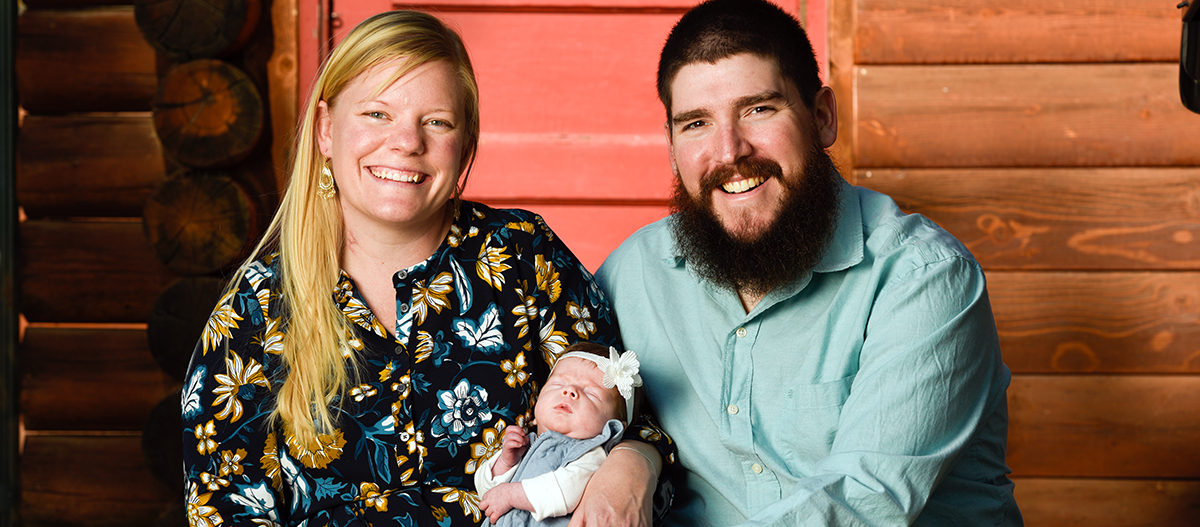
Pregnant with COVID-19: A Survival Story
CU physicians save ‘miracle mom’ and baby
By Katie Kerwin McCrimmon
April 2022
The young pregnant woman lay fully sedated and belly down in the hospital intensive care unit, attached to a ventilator that was pumping oxygen into her body at the highest possible settings.
But COVID-19 had ravaged Sarah Mays’s lungs. Even with the ventilator’s help, her blood saturation levels, which should have been hovering close to 100%, had plummeted into the 70s and 80s.
Her vitals were tanking. She was dying.
For the surgical team, it was “go time.”
Never during the pandemic had doctors at UCHealth University of Colorado Hospital put a pregnant COVID-19 patient on the last-chance, external lung and oxygenation system known as ECMO, much less delivered a 29-week preemie minutes later.
But the doctors knew that the only way to save Sarah’s life and the baby girl who wasn’t due for two-and-a-half more months was to give the mother’s lungs a chance to rest and recover. And that meant racing on the morning of August 18 to gather nearly two dozen medical experts to carefully orchestrate back-to-back surgeries: first connecting Sarah to ECMO, then performing a cesarean delivery.
Sarah’s husband, Andrew Mays, returned to the hospital after a fitful night at a hotel across the street to find that Sarah’s condition had gone “down, down, down” that morning.
No one sugarcoated how precarious things were.
Tim Tran, MD, an anesthesiologist and cardiothoracic critical care specialist who was overseeing Sarah’s care in the ICU, had to go over the worst-case scenarios. He explained that ECMO, which stands for extracorporeal membrane oxygenation, doesn’t always work for critically ill COVID-19 patients. And it’s exceedingly rare for doctors in the United States and around the world to use ECMO for pregnant COVID-19 patients. The team felt confident that they could save the baby, but no one could promise that Sarah, 32, would survive.
Tran’s warnings devastated Andrew, and confirmed fears that had been gnawing at him. Especially when he was alone at night, he felt like all his dreams were crumbling.
“I cried myself to sleep,” he said. “I thought to myself, ‘I’m not getting my wife back. I’m going to be raising a baby by myself.’ Your whole life is over, just like that.”
CONFUSED BY CONFLICTING MESSAGES
The couple met when they were juniors in high school in Michigan. They had been together 16 years and married for four. A year earlier, they bought their dream home, a charming log cabin yards from a river in a beautiful canyon just outside of a town with a perfect name: Loveland. They went fishing, hiking, and skiing every chance they got. Their golden retriever puppy, Porter, joined the family a year earlier and now their daughter would be arriving soon.
Everything seemed perfect. Then everything fell apart.
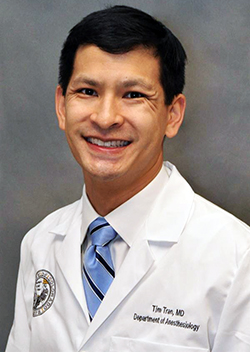 Tim Tran, MD, assistant professor
Tim Tran, MD, assistant professor
of anesthesiology, was the
cardiothoracic critical care specialist
who oversaw Sarah’s care in the ICU.
A COVID-19 infection that Andrew had contracted through work over the summer passed to Sarah in early August when she was just over six months pregnant.
Neither Sarah nor Andrew, also 32, had been vaccinated. They hadn’t opposed COVID-19 vaccines, but they felt like they were getting conflicting advice. Andrew’s mom and sister were begging the couple to get vaccinated. Sarah’s mother opposed the vaccine. Sarah’s pregnant midwife (who didn’t work for UCHealth) told Sarah she wasn’t getting vaccinated.
On top of confusing messages, Sarah hated needles. So, putting off a vaccine seemed like the simplest choice.
When the virus struck them, they struggled with guilt and deep regrets, but by then it was too late.
The clinical trials for COVID-19 vaccines had not included women who knew they were pregnant. Some trial participants became pregnant after enrollment and did well with the vaccines. Still, because there was so little data initially about COVID-19 vaccines for pregnant patients, the Centers for Disease Control and Prevention was slow to release definitive guidance.
Medical experts now know that COVID-19 is extremely dangerous during pregnancy. Only about one-third of pregnant women are vaccinated and health experts have issued urgent warnings pleading with everyone who is pregnant or planning to get pregnant to immediately get COVID-19 vaccines. Month after month in 2021, the number of pregnant women who died in the United States due to COVID-19 set new dismal records.
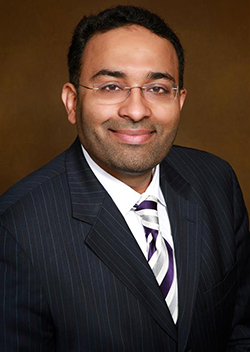 Muhammad Aftab, MD, assistant
Muhammad Aftab, MD, assistant
professor of surgery, led the team
that connected Sarah to the ECMO
machine.
PROVIDING A LIFELINE
Sarah was on the verge of becoming one of these pandemic casualties when a group of highly trained specialists teamed up to give her a lifeline.
The doctors gathered for an urgent Zoom call at about 7:30 a.m. on August 18.
The surgeries and the timing would be complex.
Muhammad Aftab, MD, is a cardiothoracic surgeon who led the team that connected Sarah to the ECMO machine.
ECMO is essentially a set of lungs outside of the body attached to a pump. Aftab and his team needed to thread wide, garden hose-sized tubes, known as cannula, from a vein in Sarah’s neck into her heart. The tubes then pull blood out of the body. The ECMO machine has an oxygenator that removes carbon dioxide from the blood and replenishes it with oxygen. The oxygenated blood then flows back to the heart. Normally, a person’s lungs do this job. For Sarah, the ECMO machine would have to take over.
“Sarah had severe infection and inflammation in her lungs. She had what’s known as acute respiratory distress syndrome (ARDS). The lungs are made of millions of alveoli. Sarah’s were filled with fluid and unable to exchange oxygen,” Aftab said.
“ECMO doesn’t fix that problem. It buys time for recovery and allows the lungs to heal,” Aftab said.
Doctors at University of Colorado Hospital have been doing ECMO surgeries for 10 years and have the largest, most experienced ECMO team in the Rocky Mountain region. Their depth of knowledge and ECMO research have proven invaluable over the last 18 months as critically ill COVID-19 patients needed “Hail Mary” ECMO treatments to survive.
Aftab recently presented research showing that in the early part of the pandemic, from April to October 2020, nearly 63% of COVID-19 patients who went on ECMO survived at multiple facilities. The Delta variant hit even harder in 2021, however, and many unvaccinated patients were arriving at hospitals more gravely ill, making it even harder for ICU and ECMO experts to save the sickest patients.
ECMO doesn’t work as well for older COVID-19 patients, those who are immunocompromised, and those whose organs are already shutting down.
Doctors hoped Sarah’s age and good health before she got COVID-19 might bode well for her; so, they gambled on ECMO.
“We wanted to save two lives,” said Aftab who is also an assistant professor of cardiothoracic surgery at the University of Colorado School of Medicine on the Anschutz Medical Campus.
TEAMING UP TO SAVE LIVES
Before beginning the surgeries, the team of doctors created a detailed, step-by-step plan.
“We had to get the baby out. We were out of other options, but how could we do this safely?” said Cristina Wood, MD, an obstetrical anesthesiologist, an expert on high-risk pregnancies, and an associate professor at the CU School of Medicine.
“We went through everything: ‘OK, we’re rolling the patient in. We’re doing ‘x’ task, then ‘y’ task.’ We went over the plan, line by line, step by step, including contingencies in case anything did not go as scripted,” Wood said.
First, Aftab and his team would connect Sarah to ECMO. Next, obstetric surgeon, maternal-fetal specialist, and associate professor Camille Hoffman, MD, MSc, would take over to do the cesarean delivery. Nurses would then hand off the newborn to a team of neonatal intensive care specialists, who would focus on the infant.
On top of the double surgeries, other logistical challenges loomed. COVID-19 patients breathe better when they are face down or in the prone position. But, in order to do the surgeries, the team needed Sarah on her back. And, to make Sarah’s blood flow well once she was connected to the ECMO machine, she needed an injection of blood thinners. Those same blood thinners posed risks for Hoffman and her team. Excessive bleeding during the cesarean delivery could endanger Sarah and the baby.
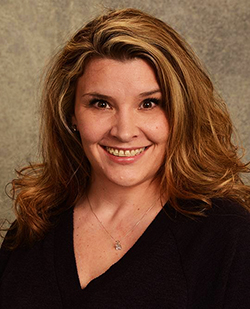 Cristina Wood, MD, associate professor of anesthesiology, helped create a step-by-step plan for the surgeries.
Cristina Wood, MD, associate professor of anesthesiology, helped create a step-by-step plan for the surgeries.The doctors kept thinking and rethinking the safest way to proceed.
“It was an amazing effort. I’m so fortunate to work with such dedicated, talented, and nationally renowned colleagues. We were able to come together utilizing our sub-specialty training and took turns managing things,” Wood said.
The sheer number of people involved posed yet another challenge. Dressed in full yellow protective gear with face masks and eye protection to keep them safe from the virus, how would anyone know who was who?
Wood has organized other complex surgeries and simulations of emergency “code blues” in the past.
“Communication is so important. Our faces were covered with masks, goggles, and ventilated hoods, so I asked one our nurses to find stickers we could write on to identify each team member and their role,” Wood said.
The nurses found fluorescent pink sticky notes and attached the improvised IDs to each person’s caps.
Once all plans were in place, the team planned to meet hours later, at 12:30 p.m., to get started. They booked the largest operating room they could find, one typically used for open-heart surgery.
‘PLEASE SAVE SARAH’
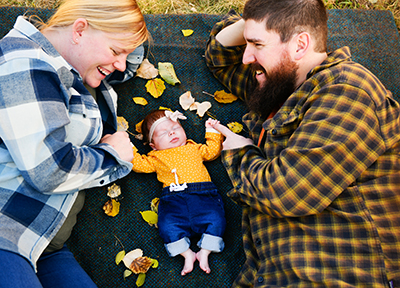 After the planning session wrapped up, doctors met with Andrew.
After the planning session wrapped up, doctors met with Andrew.
Aftab still was dressed in a suit, rather than surgical scrubs. He had been scheduled to see several patients during an outpatient clinic that morning but canceled all those appointments to focus on Sarah.
As Aftab described how the ECMO machine would work, Andrew wept. He felt responsible for bringing the virus into their home. He and Sarah both kicked themselves when they got sick.
“Whatever you need to do, please save Sarah,” Andrew begged.
Aftab held Andrew’s hand.
“I told him, ‘We are here to help. We are going to take good care of Sarah. We will do our best to give her the best possible chance to survive,’” Aftab said.
Andrew nodded and felt some comfort.
“It made me feel like he was a person too. I was going through serious stuff, but he was going to do everything in his power to save Sarah.”
Before the surgeries started, Andrew had time to visit Sarah once more and give her a pep talk.
He suited up in full protective gear, shuffled into the room, and bent far down so he could try to get face to face — or in this case, mask to ventilator — with Sarah.
Her eyes were closed.
“She was completely out of it,” Andrew recalled.
Still, he prayed that she could hear him and feel his love.
RIDING THE COVID-19 ROLLER COASTER
Sarah had been riding what doctors described as the “COVID-19 roller coaster” for weeks. People who are sick with the coronavirus — both at home and in hospitals — can seem to improve, then get worse, then rebound again, and suddenly crash. That’s one of the reasons why COVID-19 is so dangerous.
That’s partly why Sarah got so sick. She thought she was recovering. Then, she couldn’t breathe.
COVID-19 had hit both Andrew and Sarah hard in early August. He had attended a small in-person meeting at work. One co-worker was vaccinated and didn’t get sick. The rest soon tested positive. Andrew tried to keep his distance from Sarah, but two days after he got sick, so did she.
At one point, Andrew got dehydrated, and he and Sarah went to the ER at UCHealth Medical Center of the Rockies in Loveland. Sarah was coughing. Staff members took their vitals, said they were OK, and sent them home to recover.
Over time, Andrew started to improve, and Sarah hoped she was a day or two from feeling better too. Instead, she declined dramatically. She was coughing around the clock and couldn’t catch her breath. The woman who loved zigzagging up hiking trails soon could not stand up in the shower or climb a single flight of stairs to the couple’s master bedroom.
Sarah’s grandmother in Michigan was so worried that one day she sent an ambulance to bring Sarah from her home in the Big Thompson Canyon back to the hospital in Loveland. The paramedics called Sarah when they were en route. Sarah thought she could tough it out and told the paramedics they didn’t need to come.
Finally, after about two weeks of struggling, Sarah knew it was time to get help. Andrew took her to an urgent care facility. Her oxygen saturation was low: 84%. The providers called an ambulance, which took Sarah first to the hospital in Loveland, then on to University of Colorado Hospital, where specialists could better care for Sarah and her baby.
She arrived on August 13 and had to go on a ventilator the next day. After five days of multiple ups and downs, she was heading into surgery. Andrew was terrified but tried to be positive for Sarah.
“I was quite emotional,” Andrew said. “I held her hand and stroked her leg. I tried to be calm so I could calm her down. I told her everything was going to be fine. She needed to be strong. Sarah is not good with doctors, hospitals, needles, and all of that. It was very, very stressful before she got put on the vent.
“But you feel like there’s a glimmer in there. I was trying to convince both of us that everything’s going to be OK.”
He promised Sarah that soon they would both meet their baby girl.
“I can’t wait to get both of you home,” he said.
Then, Andrew had to say goodbye.
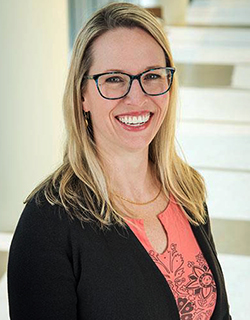 Camille Hoffman, MD, MSc, associate professor of obstetrics and gynecology, led the team that conducted the cesarean delivery of Kabrini after Sarah was connected to the ECMO machine.
Camille Hoffman, MD, MSc, associate professor of obstetrics and gynecology, led the team that conducted the cesarean delivery of Kabrini after Sarah was connected to the ECMO machine.THE DANGERS OF COVID-19 DURING PREGNANCY
Soon after Andrew left Sarah’s room, doctors got a new, ominous update.
“Sarah had worsened. Everyone was worried that her heart was going to stop. If a pregnant woman codes, neither she nor her baby are going to live unless we act quickly,” said Hoffman, the obstetric surgeon.
“We were hoping for a little more time,” added Wood, the obstetric anesthesiologist. “But we obtained additional labs and realized we had to pull the trigger. We needed to go.”
The doctors raced into the operating room ahead of schedule and got underway by about 10 a.m.
As planned, Aftab began. He and his surgical fellow, Jeremy Leonard, MD, connected Sarah to the ECMO machine. The procedure took about an hour and went very well. Immediately, Sarah began to rebound. Her vitals were looking good, and her oxygen saturation levels climbed back up close to where they belonged.
In fact, Sarah looked so good so quickly that Hoffman wondered for a moment if she should delay the cesarean delivery and give the baby more time in her mom’s belly.
The team persuaded Hoffman that it was best to proceed as planned. The ECMO machine was doing its job, but sustaining another life is hard work and Sarah needed a break.
“The physiology of pregnancy takes a lot of blood flow from the mom and sends it to the placenta for the fetus. If the mom is dying, you want to let all the blood return to the mom. You take the baby out as a life-saving measure,” Hoffman said.
At 11:42 a.m., tiny Kabrini Mays made her debut. She weighed 3 pounds, 4.9 ounces, and stretched 15 inches long.
“She looked great for a 29-weeker,” Hoffman said. “She was vigorous. She was pink. She made a little crying effort, which is always heartwarming.”
Kabrini was named after the Mother Cabrini Shrine along I-70 west of Denver. On ski trips, Sarah and Andrew always noticed the sign and thought the name spelled with a “k” would be perfect for a girl.
Hoffman handed the newborn off to neonatal expert, Jim Barry, MD, and his team from the NICU.
By about 1 p.m., the surgeons were finishing up and both mother and baby were doing remarkably well.
The doctors were in awe of what they had just experienced.
“I’ve never been through anything like this. I will never forget this case,” Hoffman said. “We came together quickly. Everyone interacted so well as a team.
“The best-laid plans worked out as well as we possibly could have hoped. There were so many steps, and everything went exactly as planned. That never happens in obstetrics. We all were so happy and relieved,” Hoffman said.
SARAH’S RECOVERY
Most ECMO patients need to stay on the machine for 10 days to 2 weeks, some even longer.
Sarah proved to be anything but typical. After just three days, Sarah was becoming more alert and felt a desperate pull to meet Kabrini and reunite with Andrew.
“She woke up on the 21st and said, ‘I’m going to be out of here in two days,’” Andrew recalled.
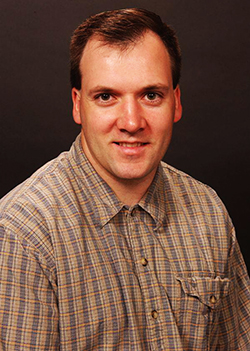 Jim Barry, MD, associate professor of pediatrics, and his team from neonatology took over Kabrini’s care after she was delivered.
Jim Barry, MD, associate professor of pediatrics, and his team from neonatology took over Kabrini’s care after she was delivered.A day later, Sarah got to see her daughter via video.
“That motivated me to get out of bed,” Sarah said.
Andrew cuddled with Kabrini and told her, “Mommy loves you and is going to see you very soon.”
Sarah was rebounding far faster than anyone expected.
It wasn’t really a surprise to Sarah.
All along she had had a feeling that she was going to survive. She remembered almost nothing from the time she arrived at the hospital. And she had a sense of how rough things had been on Andrew.
“I know how terrified I would have been, but all along, I kept hearing his voice. I heard, ‘You’re going to be fine.’ He must have been saying those things to me,” Sarah said.
As Sarah improved, the ECMO team decided to test Sarah’s lungs. They clamped the cannula on the ECMO machine — without removing them — to see if Sarah could maintain her oxygen levels.
She did well.
Her next challenge was to regain some strength, and to do that, her team needed her to get up and try walking. The blood-filled tubes from the ECMO machine still were attached to Sarah’s face and neck and felt extraordinarily heavy.
“Three or four nurses were helping me stand up. I could barely walk to the chair, but I was determined,” Sarah said.
Along with working on her physical strength, Sarah started pumping her breastmilk for Kabrini.
“I wanted her to have the antibodies,” Sarah said.
Wood, Sarah’s obstetric anesthesiologist, credits Sarah’s maternal instincts for her speedy progress.
“Moms are the strongest people in the world. Sarah was so determined. She walked around with these huge bypass tubes. The strength it took her to overcome that, to get off ECMO and go see her baby was incredible. I work with a variety of patient populations, but mothers always impress me the most,” Wood said.
‘I NEED TO GO SEE MY BABY’
On August 22, Andrew and Sarah learned that Kabrini was having trouble with her bowels.
She had malformed intestines that had developed early in the pregnancy and had nothing to do with Sarah’s case of COVID-19 or Kabrini’s premature birth. Kabrini would need to receive care next door on the Anschutz Medical Campus at Children’s Hospital Colorado.
The next morning, Sarah learned that Kabrini was about to be moved. She enlisted a nurse to rush her in a wheelchair to the NICU for a quick visit before Kabrini’s transfer.
“I need to go see my baby,” Sarah told her nurse.
While it’s complicated to detach ICU patients from their monitors, Sarah’s nurse sprang into action.
“She ran me as fast as she could,” Sarah said.
She sped Sarah in a wheelchair down two floors in an elevator then far across the hospital to the NICU.
“I got to hold Kabrini for two hours. It felt like 10 minutes,” Sarah said. “I gave her lots of hugs and kisses. I told her I was going to see her very soon and that she was going to be just fine. That gave me even more motivation to get better.”
By August 23, Sarah’s team removed the ECMO tubes and by August 26, she left the hospital, far sooner than anyone had expected.
“We were absolutely flabbergasted that she was getting out so early,” Andrew said.
Kabrini ended up needing surgery to fix her malformed intestines. She stayed at Children’s Hospital Colorado for several weeks and Sarah and Andrew visited every single day. For the team at Children’s Hospital Colorado, Sarah was a celebrity of sorts. Everyone took to calling her the “Miracle mom.”
Kabrini, too, seemed motivated to bust out of the hospital early. Her doctors expected her to need to stay until close to her original due date at the end of October. Instead, she was released on October 8 and got to spend Halloween at home, where Kabrini donned a mermaid costume.
“Everyone at Children’s was so sweet and luckily Children’s is the No. 1 pediatric gastrointestinal hospital in the nation,” Sarah said.
GET VACCINATED
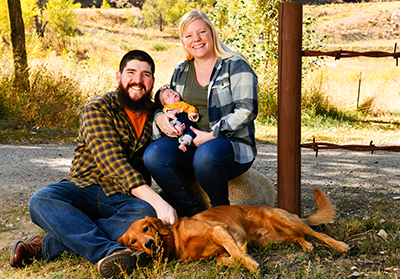 These days, Andrew and Sarah feel blessed to celebrate every milestone, including their recent wedding anniversary.
These days, Andrew and Sarah feel blessed to celebrate every milestone, including their recent wedding anniversary.
Andrew can’t stop kissing his “girls.” After all his family endured, he is relishing simple moments.
Kabrini is growing fast. She now weighs 8 pounds, more than double her birth weight, and she is nearly 20 inches long. She makes funny faces and expresses herself with her arms.
Both Andrew and Sarah — and all their doctors — are on a mission to encourage people to get their COVID-19 vaccines. They want all people, including those who are pregnant, to protect themselves and avoid scary ordeals, like the one the Mays endured.
“If I would have heard a story like mine, there’s no doubt in my mind that I would have walked right in and gotten the vaccine right away,” Sarah said. “I strongly encourage everyone — particularly pregnant women or those who want to get pregnant — to get the vaccine.”
“If I had gotten vaccinated and still got sick, chances are I could have fought the virus more easily,” Sarah said. “Please strongly consider it. I went back and forth so much, and I wanted to do the right thing.”
Andrew already has received his first two vaccine doses. Sarah’s doctors recommended that she wait 90 days after being released from the hospital. She’s now slated to get her first vaccine dose around Thanksgiving, an occasion when her entire family will mark the holiday with extraordinary gratitude.
Tran, Sarah’s ICU doctor, also is pleading with people to get vaccinated.
“It’s remarkable that Sarah survived,” said Tran, who is an assistant professor at the CU School of Medicine. “Sarah was very fortunate. A lot of people aren’t as lucky.”
Nearly all the people who are dying now of COVID-19 are unvaccinated. Their illnesses are largely preventable, Tran said.
Sarah’s survival gave caregivers a big boost just when they needed it.
“We are all very demoralized,” Tran said. “Please get vaccinated.”
Both Sarah and Andrew have some post-traumatic stress from all that they endured. While Sarah was released from the hospital quickly, she temporarily lost her speech and suffered deficits in her short-term memory. She has fully recovered now, but still has flashbacks and dreams, typical responses for people who have been sedated in ICUs for long periods of time.
“I dream that I’m roaming the hospital. I’m acting like a nurse and going into patient rooms. That’s funny because I’ve always been terrified of blood and needles. But I always wanted to go into the medical field,” Sarah said.
Sarah helps manage programs that provide before and after school care for children in northern Colorado. She’s back at work now, as is Andrew, who works as a general foreman for a telecommunications company.
WELCOME HOME
Andrew never will forget the day when he finally knew everything was going to be OK.
Kabrini was still at Children’s Hospital Colorado and was doing well.
Andrew and Sarah needed to check on their house and their dog. Their neighbors had jumped in to help as the couple spent their days at the hospital with Kabrini and nights in Aurora at the Ronald McDonald House, a charity that provided them a free home away from home.
Smoke from wildfires had blocked views of the mountains for weeks over the summer and into September.
As the couple turned west from I-25 toward Loveland, Longs Peak and Mount Meeker, two beautiful, soaring peaks, jutted up into crystal blue skies.
“It was one of those moments. I couldn’t say a lot. But it hit me. I was driving and I had my wife beside me,” he said. “It was the first clear day.”
They drove farther, and as always, felt immediately at home in their canyon, with its stunning beauty and a churning river that has carved a path through soaring walls of granite. They got closer to their home, crossed one bridge over the Big Thompson and another over a smaller tributary.
There, they found their neighbors lined up in their front yard.
“They welcomed us home,” Sarah said.
She and Andrew teared up over the simple, kind gesture.
“You start to appreciate everything and not care about the little things,” Sarah said. “I look at life differently now. I’ve always appreciated my life. But, without all the help I got, I wouldn’t be here watching Kabrini grow.”
Andrew, too, often feels utterly in awe of his miraculous wife and baby.
“There are no words to describe how grateful we are. If it weren’t for Sarah’s nurses, doctors, surgeons, and prayers from around the world, we wouldn’t be here.”
A BRACELET FOR HEALING AND HOPE
Back at the hospital, during the scariest days, Andrew’s mom flew in from Michigan to support her son. She’s Jewish and brought Andrew a special “hand of God” bracelet to help ward off evil and protect his wife and baby.
“Do not take it off until Sarah and your baby are home,” Andrew’s mother told him.
Andrew wore the bracelet around the clock. And when Sarah’s survival was most in doubt, Andrew held his wrist to his wife’s hand, pressing the omen to her skin and hoping to pass along the bracelet’s healing powers.
“It’s a beacon for people who need help,” Andrew said. “I felt an extremely strong need to keep it on and to know that I had it with me.”
The bracelet seemed to work.
“I felt prayers coming to me. It was the strangest feeling,” Andrew said.
Sarah and Kabrini did indeed make it home. And once mother and baby were safely out of harm’s way, Sarah and Andrew joined hands and slid the bracelet from his wrist to hers.
“We always have it on to help protect our family,” Sarah said.
The couple plans to raise Kabrini in the Jewish faith, and when she celebrates her transition to adulthood, Andrew and Sarah plan to give her a very special gift.
“At her Bat Mitzvah, we will give her the bracelet.”
This article was originally published in UCHealth Today on Nov. 8, 2021.